Computer-Aided Image Diagnostic Designed for Enhanced Breast Tumor Diagnosis
By MedImaging International staff writers
Posted on 13 Nov 2013
Researchers are developing computer-aided diagnosis (CADx) and quantitative image analysis (QIA) techniques for mammograms, ultrasound images, and magnetic resonance image (MRI) scans to identify specific tumor characteristics, including shape, size, and sharpness.Posted on 13 Nov 2013
The lead researcher of the study, Maryellen Giger, is a professor of radiology/medical physics and director of the Imaging Research Institute at the University of Chicago (IL, USA). Currently, computer-aided detection provides a “second opinion” to a radiologist in identifying suspicious areas within mammograms. Next, radiologists will ultimately be able to use computer-extracted lesion characteristics when performing a diagnosis to assess whether the tumor is cancerous.

Image: Quantitative image analysis workstation in the Giger laboratory for assessing breast lesions observed in MRI scans, showing automated lesion segmentation, feature extraction (volumetrics, morphology, texture, kinetics), and estimation of the probability of malignancy (Photo courtesy of SPIE).
The role of quantitative image analysis is expanding beyond screening and toward application of risk assessment, diagnosis, prognosis, and response to therapy, and in using data to identify how tumor characteristics apply to disease states, according to Prof. Giger. This could lead to the comparison of a tumor’s features with thousands of similar cases, enabling the exploration of complex relationships among tumor characteristics across large populations, which may ultimately contribute to the design of patient-specific treatments. It could also be used to study the association between a tumor’s observable characteristics and cell-level data for the emerging field of imaging and genomics, with a goal of identifying genes that influence the risk for disease.
Whereas these findings are exciting for digital mammogram technology, researchers are expanding their analysis to breast ultrasound and MRI scans due to the need for clinical validation within a larger screening population.
Through research between genomics and image-based characteristics, the researchers could soon be able to clarify which tumor characteristics are related to and which complement genetic findings, with the ultimate goal of merging them to include both genetic and environmental factors in clinical decisions. Researchers are now using data-mining methods to identify those possible correlations.
The study’s findings were published October 14, 2013, in the SPIE Newsroom.
Related Links:
University of Chicago














